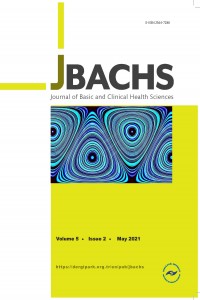Evaluation of Cardiovascular Drug Poisonings Reported to the Dokuz Eylul University Drug and Poison Information Center Between 2014 and 2017
Abstract
Purpose: The purpose of our study is to reveal the demographic features, exposure routes and reasons for exposure, clinical effects and outcomes of cardiovascular drug poisonings reported to the Dokuz Eylul University Drug and Poison Information Center (DEUDPIC) between January 2014 and December 2017.
Methods: This retrospective, descriptive, and cross-sectional study was approved by the Noninvasive Research Ethics Committee of Dokuz Eylül University School of Medicine. All data were recorded on standard data forms and then transferred to a software (Ruber, written by Engin Yildiztepe, 2007) for data analysis.
Results: There were 43 poisonings cases were reported with cardiovascular drugs. Female cases were common (60.47%). Half of the poisoning cases were toxic (51.16%). The most common reason of poisonings was intentional (81.40%). All of cases between 13-49 age group were intentional exposures. Only single substance intakes were responsible for the most of the drug exposures (62.79%). The most common agents were beta-blockers (29.85%), medicines that affect the renin-angiotensin system (23.88 %), calcium channel blockers (11.94%) and cardiac therapy drugs such as digoxin (11.94%). Clinical signs and symptoms were classified as asymptomatic (37.21%), mild (23.26%), moderate (23.26%), and severe (4.65%). Recommended treatments were observation and supportive care (46.67%), decontamination methods (44.00%) and antidote therapy (2.67%). One fatality was reported.
Conclusions: We suggest that determination of the epidemiological characteristics of cardiovascular drug exposures in our country through prospectively multi-centered studies may provide significant contributions to prevent poisonings and decrease the mortality and morbidity of the cases.
References
- 1Rang HP, Ritter JM, Flower RJ, Henderson G. The hearts. In: Rang HP, Ritter JM, Flower RJ, Henderson G (eds). Rang&Dale’s Pharmacology. 8th ed. China:Elsevier; 2016; 247-60.
- Muhit MA, Rahman MO, Raihan SZ, et al. Cardiovascular disease prevalence and prescription patterns at a tertiary level hospital in Bangladesh. J Appl Pharm Sci. 2012; 2: 80-4
- Rahman A, Raka SC, Ahmed SM. Prevalence of Cardiovascular Diseases and Prescription Patterns in A Randomly Selected Population in Bangladesh. Biomed Pharmacol J. 2017; 10: 607-13.
- Kose MR, Başara BB, Çağlar SI,et al. General Directorate of Health Research, Republic of Turkey Ministry of Health , Health Statistic Year Book 2016: 2017. Ministry of Health Publication No: 1084.
- Meenakshisundaram R, Cannie DE, Shankar PR, Zadeh HZ, Bajrachary O, Thirumalaikolundusubramania P. Cardiovascular Toxicity of Cardiovascular Drugs. In: Meenakshisundaram R, Thirumalaikolundusubramania P (eds). Heart and Toxins. New York: Elsevier; 2015; 225-74.
- Gummin DD, Mowry JB, Spyker AD, Brooks DE , Fraser MO, Banner W. 2016 Annual Report of the American Association of Poison Control Centers’ National Poison Data System (NPDS): 34th Annual Report, Clinical Toxicology. 2017; 55: 1072-1254.
- Kalkan S, Hocaoglu N, Oransay K, Unverir P, Tuncok Y. Cardiovascular medication exposures reported to Drug and Poison Information Center (DPIC) in İzmir, Turkey: A 14 year experience. Hum Exp Toxicol. 2011; 34: 53-60.
- Ayhan H, Ozucelik DN, Dogan H, Erdogan MO, Yigit Y. Suicidal Cardiovascular Drug Intoxication in Emergency Department. HSP. 2015; 2: 329-33.
- Zeinvand M, Hoseini T, Rahmani A. A Clinico-Epidemiological Study on Poisonings due to Cardiovascular Drugs in Ahvaz, Iran. Asia Pac J Med Toxicol. 2017; 6: 25-8.
- Brusin KM, Sentsov VG, Krayeva YV, Kondrashov DL, Lund C, Hovda KE. Poisonings by Cardiovascular Drugs in Yekaterinburg, Russia. Asia Pac J Med Toxicol. 2016; 5: 3-10.
- Yürüyen G, Toprak İD, Toprak Z, et al. Choice of treatment based on Turkish hypertension consensus report: Do we follow the recommendations? Turk Kardiyol Dern Ars. 2018; 46: 25-31.
Abstract
References
- 1Rang HP, Ritter JM, Flower RJ, Henderson G. The hearts. In: Rang HP, Ritter JM, Flower RJ, Henderson G (eds). Rang&Dale’s Pharmacology. 8th ed. China:Elsevier; 2016; 247-60.
- Muhit MA, Rahman MO, Raihan SZ, et al. Cardiovascular disease prevalence and prescription patterns at a tertiary level hospital in Bangladesh. J Appl Pharm Sci. 2012; 2: 80-4
- Rahman A, Raka SC, Ahmed SM. Prevalence of Cardiovascular Diseases and Prescription Patterns in A Randomly Selected Population in Bangladesh. Biomed Pharmacol J. 2017; 10: 607-13.
- Kose MR, Başara BB, Çağlar SI,et al. General Directorate of Health Research, Republic of Turkey Ministry of Health , Health Statistic Year Book 2016: 2017. Ministry of Health Publication No: 1084.
- Meenakshisundaram R, Cannie DE, Shankar PR, Zadeh HZ, Bajrachary O, Thirumalaikolundusubramania P. Cardiovascular Toxicity of Cardiovascular Drugs. In: Meenakshisundaram R, Thirumalaikolundusubramania P (eds). Heart and Toxins. New York: Elsevier; 2015; 225-74.
- Gummin DD, Mowry JB, Spyker AD, Brooks DE , Fraser MO, Banner W. 2016 Annual Report of the American Association of Poison Control Centers’ National Poison Data System (NPDS): 34th Annual Report, Clinical Toxicology. 2017; 55: 1072-1254.
- Kalkan S, Hocaoglu N, Oransay K, Unverir P, Tuncok Y. Cardiovascular medication exposures reported to Drug and Poison Information Center (DPIC) in İzmir, Turkey: A 14 year experience. Hum Exp Toxicol. 2011; 34: 53-60.
- Ayhan H, Ozucelik DN, Dogan H, Erdogan MO, Yigit Y. Suicidal Cardiovascular Drug Intoxication in Emergency Department. HSP. 2015; 2: 329-33.
- Zeinvand M, Hoseini T, Rahmani A. A Clinico-Epidemiological Study on Poisonings due to Cardiovascular Drugs in Ahvaz, Iran. Asia Pac J Med Toxicol. 2017; 6: 25-8.
- Brusin KM, Sentsov VG, Krayeva YV, Kondrashov DL, Lund C, Hovda KE. Poisonings by Cardiovascular Drugs in Yekaterinburg, Russia. Asia Pac J Med Toxicol. 2016; 5: 3-10.
- Yürüyen G, Toprak İD, Toprak Z, et al. Choice of treatment based on Turkish hypertension consensus report: Do we follow the recommendations? Turk Kardiyol Dern Ars. 2018; 46: 25-31.
Details
| Primary Language | English |
|---|---|
| Subjects | Health Care Administration |
| Journal Section | Research Article |
| Authors | |
| Publication Date | May 27, 2021 |
| Submission Date | January 7, 2021 |
| Published in Issue | Year 2021 Volume: 5 Issue: 2 |


